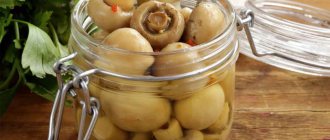Homemade soup spoils very quickly due to the variety of ingredients in any type of dish. But being busy at work doesn’t allow me to cook soup every day. It's a huge disappointment for the whole family while waiting for dinner when the fresh soup suddenly starts to bubble and foam.
To prevent souring, it is important to observe storage conditions and choose the right dishes. Pay special attention to the freshness and compatibility of ingredients. How long the soup can be stored in the refrigerator directly depends on them. Let's look in detail at how to store various first courses.
What determines the shelf life of soup?
Without refrigeration, cooked food will spoil in a matter of hours. The more degrees the room thermometer shows, the faster the “stew” will be unfit for consumption. Therefore, all first courses at home should be kept in the refrigerator, having previously set the desired temperature.
Several other factors influence storage duration:
- Sterility . Pathogenic bacteria can be found on almost any surface. Preventing premature food spoilage is as simple as keeping your kitchen clean. This means that you need to wash food and hands, change sponges and rags at least once a week, scald dishes with boiling water, regularly wash kitchen towels, clean countertops and cabinets with detergents.
- Cooking technology. Any recipe indicates not only the step-by-step actions of the cook, but also the time allotted for each heat treatment process: frying and boiling the ingredients.
- Quality of components . Using fresh ingredients, you can extend the shelf life of the finished dish by 1-2 days. Stale and spoiled ingredients, even after frying and boiling, can lead to premature souring of food. In addition, you cannot reduce the amount of salt indicated in the recipe. This traditional ingredient is used not only as a flavor regulator. It plays the role of a natural preservative and extends the life of the prepared dish. However, you should not increase the dosage either - a high concentration of salt will spoil the taste and negatively affect the functioning of internal organs.
Signs of a spoiled product
After standing in the refrigerator for some time, the soup may spoil. It is very simple to identify a stale product: you need to look at it carefully, smell it and taste it.
Signs of spoiled soup:
- cloudiness of the liquid;
- formation of a grayish film on the surface;
- sour smell and taste;
- formation of acidic foam during heating.
The spoiled dish must be poured into the toilet, after removing all large pieces and bones from the pan. It is prohibited to consume a sour product. After all, a cooked dish spoils if microorganisms that are hazardous to health begin to develop in it.
Shelf life of different types of soups
To determine the final date for the sale of soups and broths, workers at catering establishments are guided by sanitary and hygienic rules and regulations (SanPiN), and not GOST. According to accepted requirements, liquid dishes can be kept warm for no longer than 1-3 hours from the moment the stove is turned off. Then they need to be placed in a refrigerator, where it does not exceed +8°C. After 12 hours, the stew should be boiled and poured into plates over the next 30-60 minutes, and the remains from the pan should be disposed of.
Mushroom soup
Soup made from champignons or dried wild mushrooms is nutritious, high in protein, and has a pleasant and rich aroma.
But this is one of those foods that cannot be kept even in the cold for more than 24 hours.
It is advisable to cook mushroom soup in an enamel, heat-resistant glass or ceramic container. Tin, galvanized, aluminum or cast iron are not suitable, as the oxidizing metal will spoil the taste of the product and shorten its shelf life.
Borsch
In the recipe for both Siberian, Moscow and Ukrainian borscht, in addition to pork, beef and beets, a dressing based on tomato paste or sauce, vinegar, various spices and seasonings are used. These additives act as preservatives, so borscht is a kind of leader in terms of storage time.
The dish can be kept in the refrigerator for quite a long time: from 3 to 5 days, without worrying about its safety.
Cabbage soup
Shchi is a traditional Russian dish, the taste of which develops more fully on the second day. Daily cabbage soup is considered the most appetizing. The recipe may contain not only cabbage (including sauerkraut) and potatoes, but also sorrel, mushrooms and even fish. Cabbage soup with the listed ingredients cannot be stored for longer than 2 days, but those prepared according to the classic recipe can be eaten within 3-4 days.
Chicken soup
Various cereals, pasta, vermicelli or dumplings are added to it.
Chicken soup can be kept at a temperature of +2-4°C for no longer than 48 hours. And if there are fresh herbs, chicken or quail eggs, it is advisable to eat it within 24 hours.
Pea soup
Pea soup is cooked in pork or beef broth, with sausage or smoked ribs.
Can stand in the cold for 48 hours.
But before you put the pan away for storage, you need to cool it as soon as possible: pea soup, unlike potato soup, pickle soup or noodle soup, quickly turns sour in the heat.
Fish soup
A dish made from canned fish, river or sea fish (trout, pink salmon) will be tasty if eaten within the first 3 hours after preparation.
Leftover fish soup will not spoil in the cold over the next 48 hours.
Solyanka
The solyanka recipe contains pickled gherkins, capers, spices and various smoked meats. Ingredients pre-treated with marinade can be stored for a long time.
Therefore, the hodgepodge will not deteriorate and will not lose its piquant taste within 72-96 hours from the moment it is ready.
Cheese soup
The basis is meat, mushrooms or vegetables, but cheese gives a refined delicate taste and pleasant aroma. It is better to cook it for once rather than cook it for future use, but if necessary, the leftovers can be stored in the refrigerator.
If Dutch or other hard cheese was used in the recipe, the contents of the pan will have to be disposed of after 48 hours. Cheese soup with processed cheese is stored a little less - 36 hours.
Cream soup
It has a homogeneous consistency and is easily absorbed by the body, so it is often cooked for children. A variety of ingredients can be used as filling: meat, poultry, vegetables (potatoes, pumpkin, broccoli), mushrooms, herbs (spinach), legumes (green peas, lentils, beans), milk, fish, offal. When serving, it can be supplemented with shrimp, dumplings, and meatballs.
It is advisable to eat the cream soup on the day of preparation. If it is in the refrigerator - after 24 hours, and if the recipe contains milk or cream - after 12 hours.
Vegetable soup
A dish with vegetables without adding meat, fish or smoked meats will not spoil within 24 hours from the moment of preparation.
If the stew is not eaten on the second day, the contents of the pan must be boiled before pouring into plates, and the remains must be thrown away.
Milk soup
The most perishable of all soups are milk and cream. Unlike borscht or cabbage soup, which need to be steeped, freshly brewed milk soup with pasta, homemade noodles, noodles or rice tastes better when heated. Therefore, it is recommended to cook it at once. Leftovers can be stored in the refrigerator and reheated for dinner or breakfast.
The maximum storage time for dishes made with milk or cream is 12 hours.
How to freeze correctly
Housewives who have cooked too much soup often ask: can the first dish be frozen? You can put any product in the freezer, and it will definitely freeze. True, it is better not to freeze the soup, since after defrosting all the vegetables will turn into porridge. Only the broth can be frozen. Prepared for future use, it can become the basis for any soup. The broth can be frozen in a plastic container or tempered glass jar.
To defrost, the container with broth from the freezer must be placed in the refrigerator or on the table so that the liquid defrosts at room temperature. Those in a hurry can put the jar of broth in a pan with warm water.
Ukha has an unsurpassed taste only in the first hours after preparation. This dish is not prepared for future use. Fish soup made from fresh fish or canned food is eaten on the first day.
You made a huge pot of soup on Sunday, and the family has to eat it for 5 days in a row. Common situation? But you can be smarter by freezing some of the soup and making your weekday lunches more varied.
Shelf life of broths
Meat broth
Beef, pork, chicken, turkey, horse meat, rabbit will be edible for 7 days from the moment of preparation. However, it will have to be boiled every 2 days.
Fish broth
2 days is the maximum shelf life of the product. Unlike meat stock, fish stock cannot be boiled again, so any leftovers that are not used within 48 hours will have to be thrown away.
Vegetable broth
The shelf life is not inferior to meat. Can be used for such lean soups as pumpkin, bean, lentil, sorrel, and onion.
It is recommended to keep at +2-4°C for up to 5 days or freeze, after straining and removing all fragments of vegetables.
Catering - GOST rules
In cafes, restaurants and canteens, first courses are sold on the first day after preparation. Gastronorm containers called food warmers are used to store soups in public catering. These are pans (kettles) with a hermetically sealed lid, made of steel or other materials that retain heat. Some models have built-in devices to maintain a constant temperature.
The shelf life of soup in a steamer is on average 3 hours and depends on the type of broth. For example, meat with dressing must be sold within 1 hour after cooking, dairy - up to 3 hours. If prepared in advance, then cool the dish completely to +2 – 6°C and put it in the refrigerator. It must be distributed or disposed of within 24 hours.
In exceptional cases, soups made with meat broths are left in the refrigerator at +2 – 4°C for up to 18 hours. After thawing, they carry out repeated heat treatment, taste it, and only then offer it to consumers. This product must be sold within 1 hour.
Attention!
Do not mix leftover soups from yesterday with freshly prepared ones.
The shelf life of cold soups depends on the ingredients included. Leftover okroshka must be disposed of. Kvass can be stored in kegs for 5 days. If dressing is done before serving, vegetable broths can be kept in the refrigerator from 18 hours to 1.5 days.
Rules for storing soup
The following conditions must be met:
- Store food in containers that do not oxidize and do not release harmful substances into the liquid. This can be containers made of glass, earthenware, ceramics, food plastic, as well as utensils made of metal coated with a layer of enamel without chips, scratches or other damage.
- Place the pan in the refrigerator only after it has cooled to room temperature. To cool faster, in winter you can put it outside the window or on the balcony, and in summer you can put it in a bowl of cold water and add ice cubes.
- Place the container with the stew on a shelf with the lowest air temperature. In units with a top freezer this will be the first shelf on top, in models with a bottom freezer it will be the lowest.
- Remove ladle, spoons and ladles from the container, and keep the lid of the pan tightly closed.
- Use a clean, dry ladle each time for serving.
- Do not pour leftovers into smaller containers. If you still need to free up space on the shelf, when changing the pan, boil it again, cool it and only then put it in the refrigerator.
- Throughout the entire storage period, maintain in the refrigerator +2...+6°C.
The last point is especially important, since at low temperatures pathogenic microflora multiply less actively, and the food does not turn sour so quickly. For control, catering experts recommend gluing a thermometer inside the refrigerator compartment.
Cabbage soup
It's great to come home on a stormy day and have a plate of hot cheeks! Those who know a lot about cabbage soup confidently say that they are especially good when they sit in the refrigerator for 24 hours.
Usually they are boiled with meat and boldly served over the next two to three days, seasoned with sour cream and herbs. The exception would be fish or mushroom cabbage soup; it is advisable to eat these immediately or the next day.
Cabbage soup tastes better when it's steeped, but it also has an expiration date.
Is it possible to freeze soup?
It is not customary to freeze first courses. After defrosting, pieces of vegetables will turn into a soft substance that has an unattractive appearance and an unpleasant taste. Unlike ready-made fish soup or solyanka, the broth can be frozen and stored for 6 months. This method allows you to always have a ready-made base for the stew on hand. Meat, fish or vegetable broth should be kept in polymer containers or trays made of food-grade plastic and withstand freezing temperatures. The container should first be scalded with boiling water.
To ensure that the product does not spoil prematurely and retains its nutritional value, it is necessary:
- Before pouring, strain the cooked broth through gauze folded in 2-3 layers. Pieces of meat, vegetables, herbs, herbs and spices should not get into the preparation.
- Cool the hot soup base in a bowl of cold water.
- Skim off excess fat that floats to the surface.
- Pour the clear broth into trays, cover with airtight lids or cover with cling film.
- Place a sticker on each container indicating the bottling date.
- Place containers in the freezer.
- Maintain temperature -15…-18°C.
- Over the next 6 months, the frozen preparation should be used for its intended purpose: defrost and boil, and add fresh herbs and spices to add flavor.
In the freezer
Those who have tried to freeze ready-made soups have experimentally proven that after defrosting they will not be suitable for consumption. The ingredients acquire a loose consistency or become a shapeless mass. And the taste of the dish noticeably deteriorates.
Another thing is to freeze the prepared cooled broth and separately the chopped vegetables for soup. Then it will take a minimum of time to prepare the first dish.
The shelf life of meat broth in the freezer is 6 months at a temperature of -18°C -15°C. But first you will need to strain the broth to remove the thick part from it.
Borsch
How many admirers does this dish, bright in taste and color, have! Among representatives of the stronger half of humanity, there is an opinion that the ability to cook borscht is almost the main indicator of the culinary skill of the housewife. It is no coincidence that every woman has her own secrets and tricks in creating this delicious soup! One of them is to add beets, pre-boiled in their skins, and then peeled and grated on a coarse grater, along with vinegar, literally one or two minutes before readiness. As soon as the borscht begins to boil again, turning a fiery burgundy color, you can turn off the stove!
There is still debate about how long borscht can be stored. In fact, it all depends on the type of meat: the fattier the piece of pork or beef, the longer the borscht will be good for. Experts say that this king of soups can be stored for up to five days.
Lagman
Simply delicious! The unique aroma of bell peppers, spicy notes of garlic and, of course, pieces of meat that melt in your mouth. It is preferable to cook in a cauldron, but it is also possible in a saucepan. The noodles, of course, should be cooked separately so that they can be mixed together in the plate.
Despite the meat base, a large number of vegetables shortens the “life” of lagman to two, maximum three days.
The main thing in lagman is freshness!
Freezing
Is it possible to freeze soup or borscht for storage? Many people are interested in this question, especially if the dish is prepared in large quantities.
Unfortunately, this type of storage is not suitable for first courses. Potatoes and cabbage after defrosting are an unappetizing mass, which not everyone will like. But freezing the broth is a very real idea. This will help save time for preparing borscht. You can also freeze the vegetable dressing separately, placing it in portions in small tight bags.
Conditions for proper storage
- The main factor is temperature. Not higher than +5 degrees Celsius. During the hot season, it is recommended to lower the temperature another couple of degrees.
- It is highly undesirable to leave a spoon or ladle in the container. This promotes rapid souring.
- It is not recommended to transfer a finished dish for storage from the container in which it was prepared into another, for example, a smaller one, even in order to save space in the refrigerator.
- Ladle soup into bowls only with a clean, dry ladle.
- It is convenient to heat the cooled soup in the required quantity in a separate container.
- If necessary, soups can be stored in a thermos, but no longer than two to three hours.
Soup tricks
- bay leaf is an almost irreplaceable spice when it comes to soups;
- when it’s not yet the season for fresh herbs, dried dill and parsley will come to the rescue;
- when sautéing onions and carrots, it’s a good idea to add a small spoonful of sugar for caramelization;
- it is not necessary to boil the beets for an hour, twenty minutes is enough and immediately under a stream of ice water until they cool completely, so they will become soft and sweet;
- The gills and eyes are removed from the fish heads; they contain bitterness.











